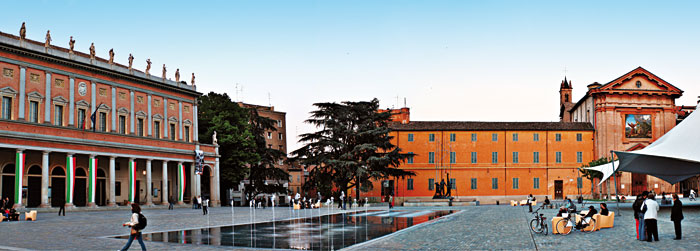Modena and Reggio Emilia: Two welcoming cities
Modena, bringing you closer to Europe and the world.
A province at the crossroads of fine cars and excellent foods.

With a population of 180,000, Modena is a city where you can enjoy the good life, whether it is through beautiful music, fine cuisine, or the high speed of a sports car. Ferraris and Maseratis can often be seen gliding down the roads of Modena and its surroundings – this is the area where the two legendary car makers are based.
After the Second World War, the area was economically depressed and there was very little industry. However, within the space of only fifty years, the city and the province are now acclaimed throughout the world for their flourishing and prosperous industrial districts and their cultural events and gastronomy. Today, Modena is one of the most advanced provinces in Europe, ranking 10th for average income per capita in Italy (2007 survey from Il Sole 24 Ore - Italy's leading financial daily newspaper).Modena is also rich in architectural treasures such as the Ghirlandina Tower, the Cathedral and Piazza Grande, which was added to the World Heritage list by UNESCO in 1997. Other attractions in the province include Carpi and its renaissance architecture, the Ducal Palace of Sassuolo, and the Nonantola Abbey (italian).
Among the city's contemporary landmarks are works by great architects such as Aldo Rossi, who designed the San Cataldo Cemetery, and the Ferrari Gallery by Massimo Iosa Ghini. In March 2012 the new Enzo Ferrari house museum was opened.
The people of Modena are lovers of theatre and music. Each year, the province is a stage for more than 1,500 live performances and the Fondazione Emilia Romagna Teatro, a foundation for the production and promotion of theatre, has its headquarters in Modena. It is not surprising that Modena is the hometown of one of the greatest tenors in history, Luciano Pavarotti.
The rich calendar of cultural events held every year in Modena also includes the prestigious Festival of Philosophy, an event attracting tens of thousands of people.
The city is also home to a collection which is unique in the world, the Museo delle Figurine, a museum dedicated to stickers which belong to the City of Modena and the Panini Publishing House, which is also world renowned for comic books and gadgets.
Modena is also synonymous with fine cuisine with specialties such as tortellini, zampone, Parmigiano-Reggiano cheese, Lambrusco wines, and traditional Balsamic Vinegar. The territory boasts numerous restaurants ranging from those reviewed in the most prestigious guidebooks to quiet, peaceful inns with traditional cooking.
For information on Modena and its surrounding areas consult the Visit Modena website. Video guides of historical sites of Modena can also be viewed online.
Reggio Emilia, a European city
at the cutting edge of education,
auto mechanics and the food industry.

Reggio Emilia has a population of 164,000, while the entire province has approximately 510,000 inhabitants. It is a medium-sized city for Italian standards, making it enjoyable to visit and tour, particularly following the recent restructuring of its historical centre. Reggio Emilia is easy to get around on foot or by bicycle (thanks to an extensive network of cycling paths), and it is a place where one can enjoy nature and fresh air (thanks to its 31 parks). It abounds in world-class cultural activities, not normally found in a city of its size.
Reggio Emilia boasts three theatres offering top-class opera, concert and drama performances. The city is also home to a wide network of libraries, museums, galleries and cultural centres especially aimed at young people.
Today, Reggio Emilia is home to many ethnic groups and is becoming increasingly multicultural, with 11.4% of its population consisting of foreign residents. The city has one of the most advanced educational and social welfare systems in the country (and in Western Europe), considered one of the most innovative and relevant examples of a community with a strong social cohesion.
The province includes several towns of historical and cultural importance (such as Correggio and Scandiano) and has a beautiful countryside, with its gently sloping plains along the Po River, the Apennine mountains and several villages, all of which are popular destinations for excursions and vacations. For further information see the local tourist information website.
Reggio Emilia also boasts an illustrious history, including some of the great Italian literary figures of the fourteenth and fifteenth centuries from Ludovico Ariosto (to whom the Ariosto Theatre is dedicated) to Matteo Maria Boiardo. It was here that the Tricolour Italian Flag was proclaimed (a museum bearing the same name is located inside the Town Hall), in 1797, and became the symbol of the Cispadane Republic, the first republican political experiment in modern Italian history. This led to the creation, at the end of the 19th century, and again, following the Second World War, of one of the most advanced educational and social welfare systems in the country (and in Western Europe). It is considered as one of the most innovative and relevant examples of a community with strong social cohesion.
